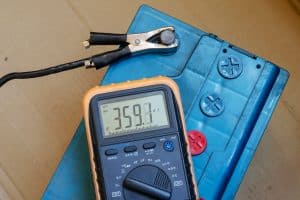The cracks in your basement floor may have gotten your attention and made you all worried and scared. But should they be a cause for concern? Don't fret, we've gathered information and asked the experts to give you a comprehensive answer to your concern.
Generally, basement floor cracks will develop over time, and it's normal and quite common. However, some cracks pose a cause for concern. If the cracks grow gradually bigger with time, become larger than 1/8-inch, cause the unevenness of the floor surface, or display other signs of serious damage to the structure, then this is the time you should be worried and must address the issue as soon as possible.
Floor cracking is caused by different factors that develop over time. Read through as we elaborate more on the topic and discuss the possible causes and the different crack sizes that will help you distinguish a normal crack from a bad or dangerous one. Additionally, we'll also answer some other important questions.

What is the most common cause of cracking in concrete?
Cracking is caused by different factors. It is one of the most common problems when using concrete in building structures or floors. But what causes concrete to crack? We've listed the most common causes below.

Shrinkage (due to excess water)
Shrinkage is the most common reason for concrete cracks. Concrete is composed of cement, water, and aggregates that are mixed to form a paste. Since some concrete mixture in residential houses has too much water in it, especially before it hardens, it affects the quality of the concrete once it dries.
Once the mixture hardens, the concrete also shrinks since the excess water has already evaporated, leaving large voids behind. This causes stress on the concrete slab that will eventually form into cracks.
The shrinking process hastens even more when exposed to hot weather. And because of this, cracks due to shrinkage will form as early as a few hours after the slab has dried.
Expansion

Concrete slabs don't only shrink, they also can expand especially during hot weather. Once concrete expands, it tends to move and pushes all that's on its way. When the pressure of the expansion continues, it causes stress on the slab and will eventually form cracks.
Changes In Temperature (Heaving)
During the winter season wherein the ground is freezing, it tends to rise a couple of inches from its original form. Once the winter season ends, thawing starts to happen and would make the concrete floor settle back in its initial form.
Since this movement is a cycle, this will eventually make your floors heave from stress due to the inability of the concrete to move with the soil.
Premature Drying
Another factor that contributes to the cracking of concrete floors is premature drying. Premature drying can cause two types of cracks namely, crazing and crusting cracks.
Crazing cracks are like shattered glass or spider webs. They have really fine crack marks and don't indicate possible structural damage. They're usually formed when the surface part of the slab tends to dry and loosen moisture quickly.
On the other hand, crusting cracks are usually formed during the stamping process, wherein a pattern is placed into the concrete slab. During a hot or windy day, a newly poured concrete mixture tends to dry up quickly, especially on the surface. And when a stamp is pressed against its surface, it creates small cracks.
Both types of cracks are not a cause for alarm since they're not a structural issue.
Subsidence Or Settling

Subsidence or settling happens when a considerable amount of void is formed below the surface of the concrete.
An example of this is when a big tree is cut or removed near a slab of concrete. Its roots below will slowly decompose and would create a void below leading to the settlement of the concrete that eventually forms cracks.
Another example is when there is an excavation to create trenches for utility lines and pipes underground, and the utility company doesn't properly compact the soil when refilling it, this would cause an effect on the quality of the concrete slab that will be placed on top of it.
This will cause subsidence over the concrete slab that would create cracks on it.
Slab Overloading
Slab overloading occurs when a very heavy object that exceeds the load limit of a concrete slab is placed on top of it. This will likely pulverize or crush the concrete.
In a residential setting, slab overloading is usually caused by the amount of weight present on the ground below the concrete slab which ultimately presses the slab down and causes it to crack. This usually happens after snowmelt or heavy rain where the ground underneath is soft and wet.
Lacking Control Joints
One of the factors that makes concrete crack is due to poor construction work. Placement of insubstantial control joints would be a factor for your slabs to crack.
Control joints serve as a foundation to your concrete slab. If there are not enough control joints to support the whole slab, over time, it'll make the slab move constantly, thus putting stress on the structure that makes it crack.
Types of Cracks In A Concrete Floor
It is important for you to know what kind of cracks you have on your basement floor to know if it's normal or not. The different types of cracks include:
1. Structural Cracks
This kind of crack is harmful and is usually larger than 1/8 of an inch. This can cause structural damage and would, later on, cause cracks to become larger. Hence, this kind of crack must be remedied sooner.
2. Settlement Cracks
This kind of crack occurs when the soil beneath the slab wasn't properly compacted, thus causing a part of the concrete slab to sink.
3. Shrinkage Cracks/ Hairline Cracks
Lastly, this kind of crack is usually harmless and is caused by different factors such as excess water, poor construction method, and temperature.
How to repair basement floor cracks

Before you start repairing the basement, you should first prepare all the needed tools to get the task done. You'll need a screwdriver, vacuum, backer rod, liquid crack filler, and masonry trowel.
For larger cracks, follow the steps below:
- The first thing that you need to do is to clean the inside of the cracks with a screwdriver or any tool that can go in there and suck up the debris or dirt. The cleaner the crack, the better.
- Next, press down into the crack some backing rods to fill in the gaps. Make sure that it should be pressed half an inch below the surface. If, however, your cracks are not that deep or big, you may not need the backer rod.
- Apply a liquid crack filler into the crack. Make sure that you apply enough by overfilling the cracks to allow for some settling.
- Afterward, you may use your wet fingers or a masonry trowel to smooth out the application. The application sets out in 30 minutes and fully cures in 24 hours.
Follow the steps below for finer cracks:
- First, it needs some crack chasing in which you have to make the fine cracks slightly bigger in a V-shape so that you have a more surface area for your filler to stick to. To do this, you can use a hammer or a chisel.
- After crack chasing, clean the insides of the crack really well.
- Apply the liquid crack filler on top.
Here is a video of the steps for your reference:
What kind of concrete do you use to patch a basement floor?
You may use a concrete patch, a mortar, or liquid crack filler to patch a basement floor.
Check out this concrete patch on Amazon.
How to seal cracks on basement floor for radon
You can do caulking on your basement floor to seal cracks for radon. The United States Environmental Protection Agency (EPA) has recommended polyurethane caulk as an effective sealant for cracks in basement floors.
In Closing

Generally, floor cracks are normal and common. However, when a crack grows larger over time, it causes your floor to become uneven, displays a gap larger than 1/8-inch, and exhibits possible structural damage that calls for immediate action.
Do you want to learn more about cracks and basement floors? Check these informative posts below:
How To Clean A Dusty Concrete Basement Floor? [Plus Tips to Reduce Dust Buildup]




